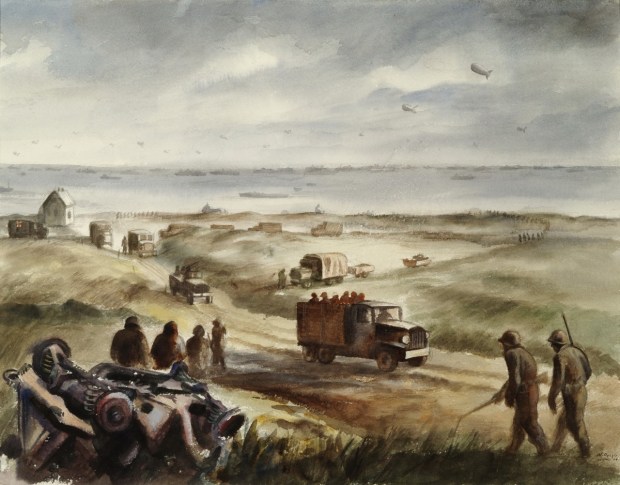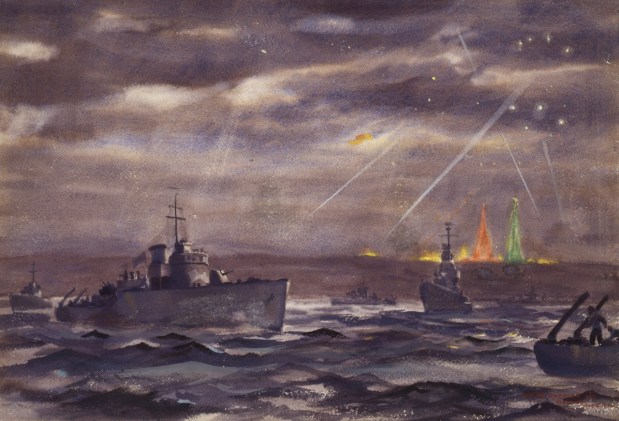In the Curator’s Words is an occasional series that takes a critical look at current exhibitions through the eyes of curators.
Long before he began painting images of war, artist Mitchell Jamieson had already established himself as a well-regarded master of his craft, having worked for the Federal Art Program painting infrastructure projects during the presidency of Franklin D. Roosevelt.
In 1942, Jamieson became an official combat artist, first depicting amphibious training. In the ensuing years, during World War II, he would join military operations in North Africa, Italy, France and eventually, Japan, where he witnessed the Japanese surrender aboard the USS Missouri in Tokyo Bay in September 1945, formally ending World War II.
 “Wounded Being Treated Aboard LST” by Mitchell Jamieson (watercolor on paper, 1944) is one of the works in “From the Front Lines to Coronado’s Backyard: 250 Years of Military Service,” which opens at the Coronado Historical Association’s museum on Nov. 1, 2025. (Naval History and Heritage Command)
“Wounded Being Treated Aboard LST” by Mitchell Jamieson (watercolor on paper, 1944) is one of the works in “From the Front Lines to Coronado’s Backyard: 250 Years of Military Service,” which opens at the Coronado Historical Association’s museum on Nov. 1, 2025. (Naval History and Heritage Command)
After the war, Jamieson said of his experience as a combat artist: “I have confined my paintings to what I have experienced and know to be strictly true, at the same time having to adapt my way of working to the pressure of time and swift-moving events. Yet anything that is worthwhile or that has the bite of reality in the work produced under these circumstances probably derives from a constant effort to share as fully as possible in the lives and experiences of others.”
Jamieson’s work, as well as those by other combat artists like him, are in San Diego this fall, all part of an exhibit at the Coronado Museum, which has gathered the works to observe the 250th anniversaries of the Navy, Army and Marine Corps.
The exhibit, titled “From the Front Lines to Coronado’s Backyard: 250 Years of Military Service,” opened Nov. 1 and is on display through Feb. 15 at the Orange Avenue museum, run under the auspices of the Coronado Historical Society.
Vickie Stone, the museum’s curator of collections, talks about how the exhibit came to be and how the pieces were chosen to commemorate a milestone anniversary.
 “First Aid Station on the Beach” by Mitchell Jamieson (watercolor on paper; 1944) is a part of the “From the Front Lines to Coronado’s Backyard: 250 Years of Military Service,” which opened Nov. 1 and is on display through Feb. 15 at the Coronado Museum. (Naval History and Heritage Command)
“First Aid Station on the Beach” by Mitchell Jamieson (watercolor on paper; 1944) is a part of the “From the Front Lines to Coronado’s Backyard: 250 Years of Military Service,” which opened Nov. 1 and is on display through Feb. 15 at the Coronado Museum. (Naval History and Heritage Command)
Q: Tell us about how this timely exhibit became a reality and ended up in Coronado. Did the Naval History & Heritage Command (NCHH) reach out to the Coronado Historical Association, or vice versa?
A: Since we collaborated with the Naval History & Heritage Command a few years ago on a successful submarine exhibit, it was a natural fit to explore another opportunity with them. We knew we had a lot of anniversaries to honor in 2025. It’s the 250th anniversaries of the Navy, Army and Marine Corps. While Coronado is widely known as a “Navy town,” the history of both North and South Island is deeply intertwined with all three branches. 2025 is also the 80th Anniversary of the end of WWII.
Knowing these anniversaries were on the horizon, last year we connected with Ariel Russell, the curator of the Navy Art Collection at NHHC, to discuss exhibit ideas. She told us about a wonderful collection of artworks depicting the Naval operations on D-Day. That got my gears turning. All three branches share a history that culminated in the success on June 6, 1944. D-Day was not just a single battle but a monumental operation involving land, sea, and air forces working in unprecedented unity. It demonstrated the U.S. military’s ability to plan and execute complex joint operations on a massive scale.
Coronado has a strong connection to WWII service, so that was another great reason to highlight this particular period in military history. Local D-Day veteran Tom Rice was a Coronado High School graduate who served in the 101st Airborne. After Mr. Rice’s passing in 2022, his family generously donated a large collection of his military memorabilia to CHA, which we had not yet had a chance to exhibit. Pairing the Navy’s art collection with the story of a local Army hero felt like the perfect connection to honor these momentous military birthdays.
 “Beach Activity” by Alexander P. Russo (watercolor on paper; 1944) is a part of the “From the Front Lines to Coronado’s Backyard: 250 Years of Military Service,” which opened Nov. 1 and is on display through Feb. 15 at the Coronado Museum. (Naval History and Heritage Command)
“Beach Activity” by Alexander P. Russo (watercolor on paper; 1944) is a part of the “From the Front Lines to Coronado’s Backyard: 250 Years of Military Service,” which opened Nov. 1 and is on display through Feb. 15 at the Coronado Museum. (Naval History and Heritage Command)
Q: The works in this exhibit are by Navy combat artists. Was this a normal part of the Navy back in the day — to have combat artists?
A: Real-time visual depictions of war date back to the Mexican-American War, the early days of photography. Later, photography was used extensively in WWI. Thinking of this timeline, it was a big surprise to me that the Navy didn’t employ artists whose mediums existed long before photography until WWII!
The Combat Art Program began in 1941 under an artist named Griffith Baily Coale, but it wasn’t until towards the end of the war in 1944 that the program was officially approved. Eight artists total, including Coale, accompanied sailors into action to document unfolding events. Three of the eight artists will have works displayed in this exhibit. It’s interesting to think that these works were made in the program’s infancy.
What’s so evocative about the work of combat artists is that they offer interpretation in the moment. Where a photograph freezes a single frame in stark black-and-white contrast, drawings and paintings can bring in elements of color, motion and atmosphere that evoke a larger sense of what soldiers and sailors were facing. The tension and anticipation of the fight to come. The courage of charging the shoreline. The horror and heartbreak of seeing a comrade fall.
 “Under the Enemy’s Nose” by Dwight C. Shepler (watercolor on paper; 1944) is a part of the “From the Front Lines to Coronado’s Backyard: 250 Years of Military Service,” which opened Nov. 1 and is on display through Feb. 15 at the Coronado Museum. (Naval History and Heritage Command)
“Under the Enemy’s Nose” by Dwight C. Shepler (watercolor on paper; 1944) is a part of the “From the Front Lines to Coronado’s Backyard: 250 Years of Military Service,” which opened Nov. 1 and is on display through Feb. 15 at the Coronado Museum. (Naval History and Heritage Command)
Q: The pieces are quite powerful, especially once you realize these were basically captured from the frontlines. There are dozens of images from the Naval History & Heritage Command. How did you end up choosing the ones you chose for this exhibition?
A: Picking art for display is one of the hardest parts of the job! There are a lot of considerations that go into it. We usually start with the narrative aspects. What artworks help support the story we’re trying to tell? What pieces grip us as curators? Do we have a variety of perspectives, both from different artists and from different parts of the operation?
Of course, there are technical and logistical aspects too. First, we have to determine if all of the artworks we want are available. The NHHC loans artworks to many other organizations across the nation, so a particular piece may not be available in the time frame we want. Also, artworks may have some conservation issues that prevent them from being displayed; maybe a painting is being cleaned at a conservation lab, or a piece is in a period of rest. “Resting” art are pieces in storage that are vulnerable to environmental exposure, particularly light. It’s an important practice that reduces continuous light exposure and helps preserve the piece’s visual integrity in the long term, but it is a bummer if it’s a piece you really wanted to exhibit. We also have to figure out what will actually fit in the gallery space. So choosing which pieces to exhibit is basically building your wishlist, then narrowing it down to what is feasible.
Q: What do you hope viewers will take away from seeing these works in person in Coronado?
A: The paintings and drawings in this exhibit are full of remembrance, which we hope will move visitors of military and civilian backgrounds alike. The Navy’s Combat Art Program is an enduring component of military operational documentation and heritage that should be appreciated.
And since the exhibit is in honor of the 250th anniversaries of the Navy, Army and Marine Corps, we also hope that visitors come away with an understanding of how our local military installations and servicemembers have contributed and continue to contribute to that larger history.
 “Loading LST on D-Day” by Alexander P. Russo (gouache on board; 1944) is a part of the “From the Front Lines to Coronado’s Backyard: 250 Years of Military Service,” which opened Nov. 1 and is on display through Feb. 15 at the Coronado Museum. (Naval History and Heritage Command)
“Loading LST on D-Day” by Alexander P. Russo (gouache on board; 1944) is a part of the “From the Front Lines to Coronado’s Backyard: 250 Years of Military Service,” which opened Nov. 1 and is on display through Feb. 15 at the Coronado Museum. (Naval History and Heritage Command)
“From the Front Lines to Coronado’s Backyard: 250 Years of Military Service”
When: Through Feb. 15
Where: Coronado Historical Association’s Coronado Museum, 1100 Orange Ave., Coronado
Admission: Free
Phone: 619-435-7242
Online: coronadohistory.org
